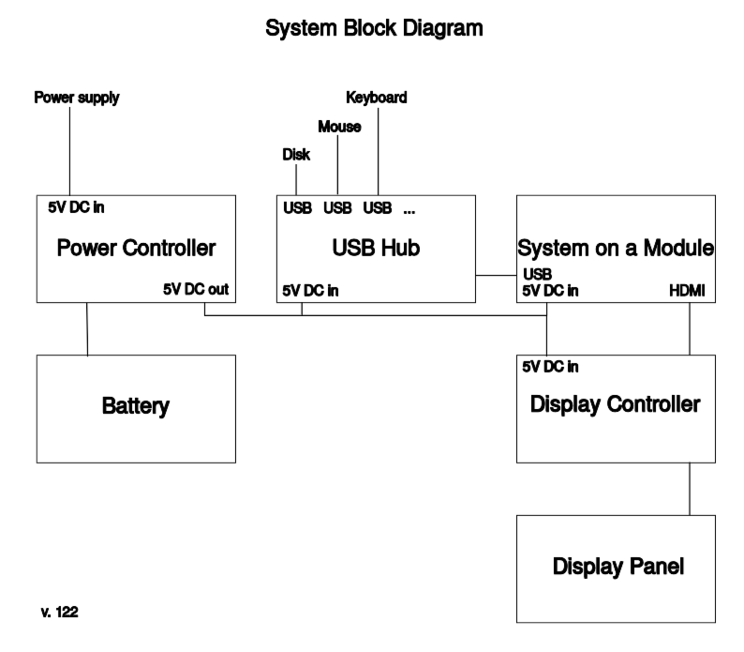Difference between revisions of "Specifications"
(→Case) |
|||
| (6 intermediate revisions by the same user not shown) | |||
| Line 22: | Line 22: | ||
See more: [[System on a Module]] | See more: [[System on a Module]] | ||
| − | ==USB hub== | + | ==I/O USB hub== |
| − | + | IO-board basically means connectivity with peripheral devices. These can be seen as on-board and out-board. On-board devices include: keyboard + trackpad, webcam and optional audio-card. USB is the usual solution for this. | |
| − | + | For more see our [[I/O USB]] page. | |
| − | ==Display Controller and panel== | + | ==Display Controller and a [[screen panel]]== |
Provides interface to display panel by HDMI | Provides interface to display panel by HDMI | ||
| + | |||
| + | Panel slim screen. | ||
| + | |||
| + | Resolution: 1920 x 1080 | ||
| + | |||
| + | Aspect Ratio: 16:9 | ||
| + | |||
| + | Pixel Pitch(mm): 0.1529 x 0.1529 | ||
| + | |||
| + | PPI: 166 | ||
| + | |||
| + | Active Area(mm): 294.06 x 165.54 | ||
| + | |||
| + | Outline(mm): 299.96 x 186.92 | ||
| + | |||
| + | Luminance(nits): 300 | ||
| + | |||
| + | View Angle (U/D/R/L): 89/89/89/89 | ||
| + | |||
| + | Contrast Ratio: 800:1 | ||
| + | |||
| + | Support color: 16.7M | ||
| + | |||
| + | Color Depth: 8 bit | ||
| + | |||
| + | Color Gamut (NTSC): 72% | ||
| + | |||
| + | Response Time(ms): 25 | ||
| + | |||
| + | Power consumption: 3.7 | ||
| + | |||
| + | Backlight: LED | ||
| + | |||
| + | Weight: 170 g | ||
| + | |||
| + | Frame Rate: (Hz)60Hz | ||
| + | |||
| + | Electrical Interface: DP 1.3 | ||
| + | |||
| + | Ultra-slim thickness: 2mm | ||
==Case== | ==Case== | ||
| + | |||
| + | Initial casing is meant to be made of a recyclable vegetable oil based plastic. Also the idea of a modular design gave us even more sustainable materials to look at - pressed used clothes in resin, cans recycled pressed aluminium and even resin-ed wood saw. | ||
| + | |||
| + | Here are elements we have been working with so far and slowly shaping the final design and a certain materials together. | ||
| + | |||
| + | On our [https://github.com/balthazar-space/case-and-design Github page] you can look into the .stl files too. | ||
| + | |||
| + | Chronological pictures and a phases of the development: | ||
| + | |||
| + | <gallery> | ||
| + | File:DownBody.png |thumb| | ||
| + | File:Frame.png|thumb| | ||
| + | File:KeyPad.png|thumb| | ||
| + | File:ScreenBack.png|thumb| | ||
| + | File:Speaker.png|thumb| | ||
| + | File:Basic1.png|thumb| | ||
| + | File:Basic2.png|thumb| | ||
| + | File:Basic3.png|thumb| | ||
| + | File:Basic4.png|thumb| | ||
| + | File:Basic5.png|thumb| | ||
| + | File:Basic6.png|thumb| | ||
| + | File:Basic7.png|thumb| | ||
| + | File:Basic8.png|thumb| | ||
| + | </gallery> | ||
==Keyboard and Touch-pad== | ==Keyboard and Touch-pad== | ||
Revision as of 04:09, 9 June 2021
This page documents features from more engineering point of view. For a more user-centric point of view, see Features.
Major Balthazar parts are:
Power Controller and battery
These supply power to the rest of the system, particularly the System on a Module, USB Hub and Display subsytem. It also manages battery.
It should be capable enough to run some USB connected hardware.
See more: Power Supply
System on a Module (SoM)
This is the main system board, the computer. Boards from different makers should be supported.
Minimum of ports is required for wider compaitibility. These are: Power, USB and HDMI.
See more: System on a Module
I/O USB hub
IO-board basically means connectivity with peripheral devices. These can be seen as on-board and out-board. On-board devices include: keyboard + trackpad, webcam and optional audio-card. USB is the usual solution for this.
For more see our I/O USB page.
Display Controller and a screen panel
Provides interface to display panel by HDMI
Panel slim screen.
Resolution: 1920 x 1080
Aspect Ratio: 16:9
Pixel Pitch(mm): 0.1529 x 0.1529
PPI: 166
Active Area(mm): 294.06 x 165.54
Outline(mm): 299.96 x 186.92
Luminance(nits): 300
View Angle (U/D/R/L): 89/89/89/89
Contrast Ratio: 800:1
Support color: 16.7M
Color Depth: 8 bit
Color Gamut (NTSC): 72%
Response Time(ms): 25
Power consumption: 3.7
Backlight: LED
Weight: 170 g
Frame Rate: (Hz)60Hz
Electrical Interface: DP 1.3
Ultra-slim thickness: 2mm
Case
Initial casing is meant to be made of a recyclable vegetable oil based plastic. Also the idea of a modular design gave us even more sustainable materials to look at - pressed used clothes in resin, cans recycled pressed aluminium and even resin-ed wood saw.
Here are elements we have been working with so far and slowly shaping the final design and a certain materials together.
On our Github page you can look into the .stl files too.
Chronological pictures and a phases of the development:
Keyboard and Touch-pad
See more: Keyboard
Software
Software depends on a System on a Module used.
See more: Software













